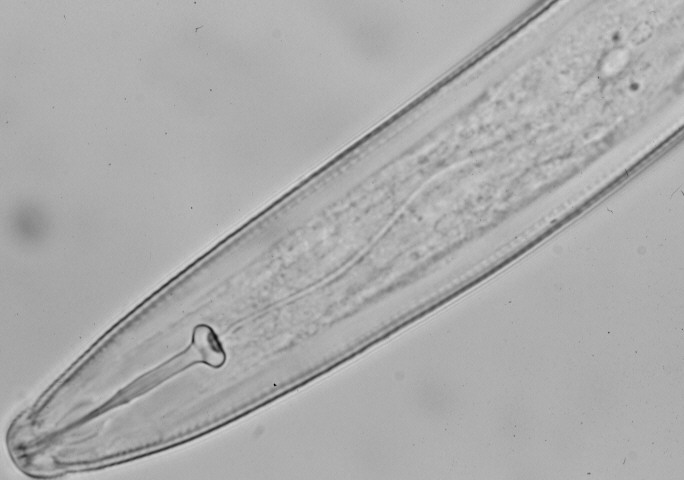

Tom Powers *
=== Adenophorea
=====|
=== Secernentea
Maggenti 1991
Nematodes are the most numerous multicellular animals on Earth. A handful of soil will contain thousands of the microscopic worms, many of them parasites of insects, plants, or animals. Free-living species are abundant, including nematodes that feed on bacteria, fungi, and other nematodes, yet the vast majority of species encountered are poorly understood biologically. There are nearly 20,000 described species classified in the Phylum Nemata. Nematodes are structurally simple organisms. Adult nematodes are comprised of approximately 1,000 somatic cells, and potentially hundreds of cells associated with the reproductive system. Nematodes have been characterized as "tube within a tube"; referring to the alimentary canal which extends from the mouth on the anterior end, to the anus located near the tail. Nematodes possess digestive, nervous, excretory, and reproductive systems, but lack a discrete circulatory or respiratory system. In size they range from 0.3 mm to over 8 meters.
Nematodes are bilaterally symmetrical "pseudocoelomates" most often with elongate, cylindrical, unsegmented, wormlike bodies covered by a cuticle secreted by the underlying hypodermis. In specialized parasites the body may be spindle-shaped, pear-shaped, lemon-shaped, or other versions of saccate. The anterior extremity is generally rounded and the oral opening is normally terminal. Characteristically the anterior extermity bears 16 sensilla that may be setiform, papilliform, or, in the more advanced forms, sensilla insitica or colea. Paired chemoreceptors (amphids) are located laterally and posteriorly to or intermingled with the four posterior cephalic sensilla. The oral opening is followed by the alimentary canal that is divisible into the stomodeum (stoma, esophagus, esophagointestinal valve), mesenteron (intestine), and proctodeum (rectum), which opens through a subtenninal anus. When present the excretory system opens through a ventromedial pore, generally anterior. The sexes are usually separate and the reproductive system in males and females are most often simple and panoistic. Teleotrophic forms with a nutritive rachis do occur (e.g. Caenorhabditis). In females the genital and anal openings are separate. In males the reproductive system forms a cloacal junction with the proctodeum. Males generally have cuticularized secondary sex organs (spicules) that may be accompanied by a guiding gubemaculum. The central nervous system is composed of the ganglionated circumesophageal commissure (nerve ring) and longitudinal nerves, the main nerve being ventral and gonglionated. The somatic musculature is largely limited to longitudinally oriented fibers. The eggs undergo determinate cleavage. The life cycle is normally direct: egg, four juvenile or larval stages, and adult. Molts occur between each juvenile stage. Nematodes are mycetophagus, herbivorous, and carnivorous; they are predators of micrometazoans and parasites of plants and animals.
Allen, M.W., and Sher, S. 1967. Taxonomic problems concerning
the phytoparasitic nematodes. Ann. Rev. Phytopathol.
5:247-264.
Andrassy, I 1976. Evolution as a Basis for the Systematization
of Nematodes. London.
Chitwood, B.G. 1937. A revised classification of the Nematoda.
Papers in Helmintholgy, 30 year Jubileum. K.I. Skrjabin,
Moscow, pp. 69-80.
Maggenti, A.R. 1991. Nemata: higher classification. In: Manual
of Agricutlureal Nematology, W.R. Nickle [ed.]. Marcel
Dekker, Inc., New York.
Page constructed by Marcella Shaver-Adams, madams@unlgrad1.unl.edu.
Tom
Powers
E-mail: tpowers@unlinfo2.unl.edu.
Department of Plant Pathology, 406 Plant Sciences Hall, P.O. Box 830722,
University of Nebraska-Lincoln, Lincoln, Nebraska, USA 68583-0722
Page copyright © 1997 Tom Powers and Society of Nematology Systematics
Resources Committee
Last saved 16 July 1997
left: juvenile Steinernema sp. right: head of Nagelus sp. from Churchill, Manitoba, Canada.